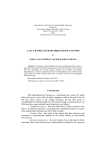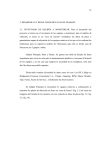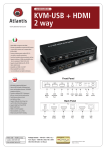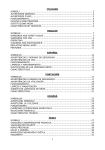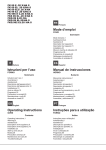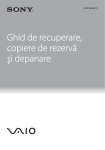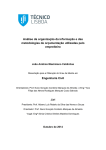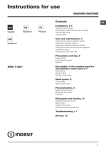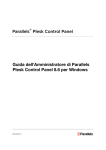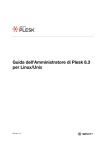Download modern microcontrollers as virtual devices for old microprocessor
Transcript
BULETINUL INSTITUTULUI POLITEHNIC DIN IAŞI Publicat de Universitatea Tehnică „Gheorghe Asachi” din Iaşi Tomul LV (LIX), Fasc. 2, 2009 SecŃia AUTOMATICĂ şi CALCULATOARE MODERN MICROCONTROLLERS AS VIRTUAL DEVICES FOR OLD MICROPROCESSOR SYSTEMS BY VLAD VASILIU and *ALEODOR DANIEL IOAN Abstract. The main idea behind this work is to find a way to simplify the microprocessor based systems. Our solution is to replace all input/output chips (like serial, parallel, timers, etc.) with a single microcontroller that can have more interconnectivity capabilities. We can imagine a new kind of virtual I/O devices implemented in microcontroller by software. This combination of modern microcontroller technology with old standard microprocessor systems can be effective and powerful for many low cost industrial control systems. The proposed configuration can offer a new perspective over the actual research in microprocessor systems which are oriented to industrial control applications. Key words: Microcontroller, embedded systems, multi I/O controller, interrupts, virtual devices. 2000 Mathematics Subject Classification: 68M01, 94C12. 1. Introduction Very simple microprocessor based systems have a memory block, an I/O block, a logic part for memory & I/O selection and of course a microprocessor [1]. The problem to solve is to reduce the complexity, because if we want a system with serous interconnectivity capabilities we must add some I/O controllers. That means problems in routing, some problems in programming, and some problems linked to the dimension of the board. So we must adopt a new configuration in order to obtain what we want. The main idea is to remove all I/O hardware controllers, and replacing them with a microcontroller. The research started with a simple application for this configuration. The application is in fact Z80 based micro system [2] with 64Ko+32Ko SRAM and for I/O part we used a PIC16F877 [3] because this microcontroller is very 40 Vlad Vasiliu and Aleodor Daniel Ioan easy to connect to a data bus. Even if Z80 is at least 30 years old, it has a very smart way to solve the interrupts and ZILOG has new versions for this microprocessor, with capabilities that can be compared with newer devices. Initially it was intended just to use all on-chip interfaces that PC16F877 had to replace all hardware I/O controllers (SIO = Serial I/O, PIO = Parallel I/O, CTC = Counter/Timer Controller) from a classical Z80 system [1], in order to have a very compact board. When the hardware configuration was defined, it was clear that the PIC microcontroller can do much more. Because the microprocessor has a powerful instruction set with sophisticated addressing modes for the large external memory and because the microcontroller has an internal processing unit with less capability, but a comprehensive range of peripheral circuits, the resulted combination can be very useful and effective in a low cost system. All capabilities will be discussed later, but some hardware issues must be first understood. 2. Hardware Configuration The goal beyond the chosen hardware configuration was to build a modular electronic schematic. So, the whole project was divided in two parts: the Z80 microprocessor with its own SRAM memory module and a “multi I/O” interface based on PIC16F877. The Z80 module contains the following three sub-blocks: a) The main memory block with the first 32 Kbytes FLASH shadowed by 32 Kbytes SRAM and the second 32 Kbytes SRAM that can be switched with another 32 Kbytes SRAM; b) The logic part that consists in small J-K flip-flops based automaton with a very simple state machine used for memory blocks paging; c) The combinational part for decoding I/O ports, because in this present configuration we can connect a LCD and a tweeter without using the PIC part. Even if the Z80 can access only a window of 64 Kbytes at the same moment [2], we can improvise a method to add more memory. The whole effort can be explained if we consider that the Z80 has special instructions to manipulate memory areas. Just because it is an old microprocessor, the number of instructions that interact with memory is not limited (if we want to create a very rapid processor we must limit the number of instructions that use memory or I/O) and, for the Z80 in particular, the instruction set is very powerful [6]. For this project, the solution was to shadow the FLASH memory and to add two blocks of memory that can be switched by software. After the system RESET, the memory map looks like in the Fig. 1. The method that can be used to switch memory configurations after the next instruction was fetched form the old memory map is very well known by the old Z80 specialists [2]: the refresh address is a 7 bit value from R (Refresh) register. This register has 8 bit width so, what about the last bit 7 ? This bit can Bul. Inst. Polit. Iaşi, t. LV (LIX), f. 2, 2009 41 (and will) be used for memory switching, because the content of the R register will appear on the address bus only at the end of the fetch memory cycle, after the next instruction was already extracted from the old configuration. 32Kbytes FLASH or EPROM 0000H 32Kbytes SRAM0 1st block 0FFFH 32Kbytes SRAM0 1st block a 32Kbytes SRAM1 2nd block 32Kbytes SRAM2 3rd block FFFFH b Fig. 1 – Memory map after RESET (a) and after the whole program from FLASH was moved to first block of SRAM (b). The logic that selects memory blocks was implemented using old style methods (JK flip-flops and decoders). This logic part can be further implemented in CPLD (Complex Programmable Logic Devices) but for “educational” reasons we wanted to be with standard ports and flip-flops [4]. The logic part works like a very small finite automaton with a “state machine” which tells what memory block is selected. After system RESET (Fig. 2), the first flip-flop (U2A) is cleared using the CLR input. Because its QA output also controls the CLR input from the second flip-flop (U2B), in this way both flip-flops will be cleared to “00”. This is the initial state, when a EPROM/FLASH memory circuit is selected in the lower half of memory map and a SRAM0 memory circuit is selected in the higher half (Fig. 1). A refresh cycle is initiated when the MREQ (Memory REQuest) signal becomes low, but only after the RFSH (ReFreSH) signal was already asserted low [2]. In this moment, the content of the R register will appear on the lower half of the address bus and the last bit 7 from R will be visible on the A7 address line. The deactivation of both signals at the end of the refresh cycle will trigger the flip-flops clock input to allow extra time for address bus stabilization. The “00” initial state will remain unchanged how long the A7 bit is still logical “0” during all refresh cycles. When the A7 bit is changed to logical “1”, both flip-flops will be set to “11” state, which selects a new memory configuration: the SRAM0 window will become visible at the lower addresses and another SRAM1 block will be selected in the higher half of memory map, instead of SRAM0. The EPROM/FLASH memory cannot be addressed in this 42 Vlad Vasiliu and Aleodor Daniel Ioan configuration, but its content was already copied to SRAM0 in the initial configuration. Fig. 2 – Using two JK flip-flops to control the memory decoder. If the software then clears the bit 7 from R register, the first flip-flop will remain “1” because the K input is not used, but the second one will be cleared because it was connected to function as a “D” flip-flop. The third “10” state will now select another SRAM2 instead of SRAM1, for further memory expansion. How long the system will not be reseted, the initial “00” state cannot be reached anymore. The “10” and “11” states can be interchanged under software control, to allow memory page switching between SRAM2 and SRAM1. The input/output module contains just the PIC16F877 and a flip flop, to generate WAIT states if necessary, when the Z80 module wants to communicate with the I/O part. Even if we add some wait states, because there are instructions which send data blocks (not just a byte), we can generate a burst data transfer in this configuration. This is a good reason for the old Z80 microprocessor usage, because most of today microprocessors have just two instructions for I/O transfer (like “in” or “out”). Usually, the microprocessor is more rapid than the I/O and, to obtain a good computational speed, the memory and I/O instructions in newer devices were limited to a small number. But the old known Z80 is an exception to this rule and is well suited for I/O transfer. More than that, the Z80 has some complex instructions that can compensate the speed issue [6]. The I/O module can generate interrupts. It is a simple way to interact with a microprocessor, but more than an “expected” construction can be used due to the Z80, which has a simpler (let say “unusual”) method to resolve the interrupts. The use of this “unusual” way to solve the requests can generate a Bul. Inst. Polit. Iaşi, t. LV (LIX), f. 2, 2009 43 very flexible unit. The Z80 microprocessor has 3 modes to manage the interrupts [2]. In mode 0, the device which generates the interrupt can put on data bus any instruction for the processor to execute. Usually this instruction is a JUMP (relative or absolute). But we can generate with the PIC 16F877 any instruction (it can be a jump to any location, or we can transmit a code to execute without storing the instruction in the memory). The interrupt is considered “solved” when IRET instruction is executed. This means that we can send the instruction, or the microprocessor can read it from memory. Two small issues should be discussed in the following. In an interrupt cycle, there are at least two hardware WAIT states implemented for each interrupt cycle [6]. That means that if we send instructions in this mode, the whole system will be slowed down. But in some moments, when the system could be slowed down, we can load some interrupts routines. If the application permits, a whole new interrupt vector with all interrupts routines can be loaded. In this way, the code will be dynamically allocated on-the-fly, without stopping the system and without rewriting the EPROM or the FLASH memory. The PIC based system can be a debugger and a multi I/O at the very same time. Practically all the code from the memory can be modified remotely, without any physical intervention. This is the reason why a method to interchange between the FLASH memory and a SRAM, with the possibility to copy all the FLASH into the SRAM, was implemented using a J-K flip-flop that can be set only one time. The flip-flop is first cleared at system RESET. So, when we start the system, we can copy the FLASH into the SRAM and after that we can modify all functions that were written by default. One more issue is that the M1 signal must be considered at decoding. Most Z80 projects were built around Z80 family (PIO – the parallel interface, SIO – the serial interface and CTC – the timing interface). All interfaces from this family internally decode the M1 signal by construction [7]. The content of program counter will appear on the address bus at interrupt acknowledge, which means that if only IORQ (Input/Output ReQuest) signal would be used at decoding (together with some addresses, of course) then another interface could be selected simultaneously within the interrupt acknowledge cycle. Another way to manage the interrupts is to jump to a specific address (mode 1). The technique isn’t so good to use when we have more I/O devices. A specific way to solve the interrupt requests is the mode 2. This is the Z80 native response to interrupts, but in this dual system it can be used well in combination with mode 0. The PIC16F877 microcontroller can be also interrupted by the Z80. The biggest advantage of this proposed system configuration is that we can make benefit of the “parallel slave port” (PSP) facility of this microcontroller [5]. This means that we can connect the PIC directly to the main processor bus, using hardware strobes for data transfer, without the need of software control. 44 Vlad Vasiliu and Aleodor Daniel Ioan For this feature we must sacrifice two ports: PORTD and PORTE. The PORTD contains all the eight data bits required for the transfer and the PORTE contains RD (ReaD), WR (WRite) and CS (Chip Select) hardware strobes [8]. Every time when the main processor reads or writes data from or to this PSP port, an interrupt is automatically generated to the microcontroller central processing unit. So, it is very easy to interface one of these microcontrollers to a system with main Z80 microprocessor. Well programmed this device can be used like a timer, serial port, parallel port, I2C port, SPI port, or we can make use of the 10 bit integrated ADC or other peripherals that are in this particular PIC microcontroller (like the EEPROM nonvolatile memory block) [9]. It should be noted that the Z80 family of peripherals does not contain I2C or newer standards! Is obvious that is simpler to interface only one I/O chip instead of three or four old chips, and more than that, we can set a specific ISR (Interrupt Service Routine) for each virtual software device. The PIC can transmit any instruction to the Z80 using mode 0 interrupt response and a newer ISR routine could be loaded at any time. Using PIC generated instructions, we can change the position of such routines in the memory and we can make live updates for them. The interrupt mode 1 or 2 can be also used. In this case, any ISR could be loaded with a little help from a boot-loader or an operating system. More than that, we can create “virtual devices”, because the input and output is in fact a software function which is called by an ISR when an event appears. In this way some calculation can be done in parallel. 3. Practical New Multi-Controller Topology Usually, when we think about a multiprocessor system, most of the time we have in mind a processor matrix. But we are used to solve problems in a “divide et impera” algorithm. This kind of algorithm is hard to implement on a processor matrix and even if implemented, it cannot use all the computational power. Sometimes, maybe is a better solution to have another structure instead of connecting some processors to the same bus and try to make it work together. The main idea behind this “multi-controller” topology is to use the same functional module connected to a single main master processor which manages all functions that are implemented in all such functional modules (Fig. 3). From the hardware point of view, any function or sub-function has the same structure. That means that behind each block, only one microcontroller exists and this is linked to another microcontroller with an independent bus. Only the main processor bus is shared. When the problem is separated in sub-problems using a “divide at impera” algorithm, a specific topology will be generated. So, the very same problem can have two or more specific hardware solutions. In this way, some production costs can be avoided. Because one microcontroller implements only Bul. Inst. Polit. Iaşi, t. LV (LIX), f. 2, 2009 45 one function and in the most of the time will be “idle”, something like crosscheck between controllers could be built. The common problem found in microprocessor systems is higher rate of failure due to the presence of busses. The solution is to use a “single-pack” system that is encapsulated on the very same silicon chip. Sub function Sub function Sub function Function 6 Sub function Function 5 CPU Core Sub function Function 4 Memory Function 3 Sub function Function 2 Sub function Function 1 Sub function Layer 1 Layer 2 Fig. 3 – Basic multi-controller topology. The discussed configuration can be extended to another level, where 4 or more processors can be interconnected together. The controllers from a near level of a processor can become the controllers from a distant layer of another processor (Fig. 4). Layer 2 CPU Cor Device Layer 2 CPU Cor Fig. 4 – Shared virtual device. 46 Vlad Vasiliu and Aleodor Daniel Ioan In conclusion, we can imagine any construction based on these basic ideas. More than that, such structures are easy to program, are very intuitive and very object oriented. Because the construction has more layers, this reduces the traffic and the possibility of deadlock on the main bus. Because on the CPU bus we have microcontrollers, we can implement an adaptive algorithm to be sure that the bus is free when it is needed. If the software architecture is well done, after releasing a version we can easily improve any module, because the interaction between modules is very weak and a good interface can reduce all integration problems. This is a more practical configuration instead of any parallel configuration, because in a parallel configuration we have a big number of shared resources. 4. RISC Versus CISC Competition It is very unusual to have one CISC (Z80) and one RISC (PIC) processor on the same board. Further more, it is possible to want more interfaces and that means 2 or more I/O controllers. Then, what should we do with the time available between two consecutive data frames sent to the ports? In this time, the controllers are idle and they are waiting new data. So, it is possible to have one or more controllers that just wait. The appropriate question is: can the RISC controller process some operations more rapidly than the main CISC processor? If we know the answer, we can implement something like a coprocessor and move some of the calculations to the RISC controller. It is very hard to estimate the results, because it is possible that we cannot compare the controllers and the main CPU. The proposed idea is to let the main processor to compete with one or more controllers, to find out who is the best. This is a very competitive way to find out if the microprocessor can manage all functions that are integrated in the actual configuration. The mechanism is simple: call a virtual device to solve a certain problem and in the same time try to solve it. If the device wins, the microcontroller can interrupt the processor and deliver the results. If the results are computed quicker by the main CISC processor, it can mask that interrupt, so, if the controller does not receive any response, it means that the microprocessor had a result. Next, the results can be compared for a cross-check. 5. Experimental Results To test some aspects of virtual devices, we have designed and built a PCB (Printed Circuit Board), with main processor, memory and only one PIC microcontroller. The first attempt to emulate a serial RS232 compatible connection by PIC software and hardware resources, without using interrupt driven transfer, was well successful. Without any complication, we could send and receive data via the PIC16F877 to see if the communication is possible. This first test worked smoothly and after that we tried to make a similar Bul. Inst. Polit. Iaşi, t. LV (LIX), f. 2, 2009 47 connection, but interrupt driven. The second test was more difficult to be done. The PIC16F877 was initially programmed in C language, but a compiled C code is too slow for the tested configuration (interrupt vector placed in an interrupt acknowledge cycle without inserting any WAIT states). Only after the function which sends the interrupt vector to the main processor was rewritten from C to assembler language, we succeeded to send and receive data using the PIC “virtual” serial RS232 port. The Fig. 5 shows how a small text typed on the PC using the Windows “HyperTerminal” program is sent over RS232 connection to the tested system and it is displayed exactly on the LCD after it was received using the PIC internal USART (Universal Synchronous/Asynchronous Receiver/Transmitter) virtualized by PIC software. Fig. 5 – Interrupt driven RS232 serial comunication. In the third test, we tried to virtualize a timer too. We chose the TIMER1 from PIC: the main processor sends a time constant knowing the PIC frequency and the virtual controller sends back an interrupt when the timer overflows. The Fig. 6 shows the waveform of a sound generated by a beeper connected directly as classic bit I/O to the Z80 main processor. Every change in the waveform was dictated by the virtual timer overflow. Another small problem was in witch way we should manage the interrupts? So, the first test implements a simple software daisy chain but we realized that any algorithm can be implemented to manage the interrupts. This feature is very important because we can imagine new, more “adaptive” algorithms, very hard to implement in other situations. 48 Vlad Vasiliu and Aleodor Daniel Ioan Now, a “virtual device” can be easy implemented as a software application. Any function that generates an interrupt to the main processor is a virtual device. We chose to send request by using normal IO instructions, but the response is always an interrupt. When the PSP port is read in the main program, we get only a status word (a result from the PIC can be read only inside the interrupt service routines). For the future projects we want to add more controllers to see in which conditions the system can get into a deadlock and how to manage the interrupts to avoid these situations. Fig. 6 – Sound played by a beeper using software timers from PIC. 6. Conclusions In conclusion, this paper contains some practical ideas that can be used in future microprocessor systems design. In the first place, is easier to put a microcontroller instead of four or five integrated I/O devices. This can be done in any microprocessor/microcontroller based system. If this is done, then very modular software can be implemented, with a lot of virtual I/O devices that can help the main processor to finish his job faster. By using a microcontroller instead of more standard I/O devices, a simple single core system is transform in a dual core system. This means that we can make a cross-check between calculations and see if an error was generated. This feature transforms a simple system in a redundant system that is able to himself diagnose. We can make a multiprocessor system using modules that are Bul. Inst. Polit. Iaşi, t. LV (LIX), f. 2, 2009 49 equivalent from the hardware point of view, but every module can have a distinctive task to do. For a relative small number of controllers, we can create a layered structure that can make the integration of all modules in a project much easier. In this way, we can save time and cost in developing new products. In the final, a very important aspect must be highlight: the Z80 microprocessor was only a testing choice and any other processor can be used. Received: February 6, 2009 Continental AG Jassy, Software Chassis and Safety Department e-mail: [email protected] and *“Gheorghe Asachi” Technical University of Iaşi, Automatic Control and Applied Informatics Department e-mail: [email protected] REFERENCES 1. Ball S.R., Embedded Microprocessor systems: real world design, 2nd Ed., Butterworth-Heinemann, Woburn, 2000. 2. Gaonkar R.M., Z-80 microprocessor: architecture, interfacing, programming, and design, 3rd edition, Prentice Hall, New Jersey, 2000. 3. Bates M.P., Interfacing PIC Microcontrollers: Embedded Design by Interactive Simulation, Newnes Elsevier, Oxford, 2006. 4. Mano M. M., Kime C. R., Logic and Computer Design Fundamentals, 3rd Ed., Prentice Hall, New Jersey, 2004. 5. Di Jasio L., Wilmshurst T., Ibrahim D., Morton J., Bates M.P., Smith J., Smith D.W., Hellebuyck C., PIC Microcontrollers: Know it All, Newnes Elsevier, Burlington, 2008. * 6. * * Z80 Family CPU User Manual. User Manual, Zilog Inc., www.zilog.com/docs/z80/, 2004. * 7. * * Z80 Family CPU Peripherals. User Manual, Zilog Inc., www.zilog.com/docs/z80/, 2001. 8. *** PICmicro Mid-Range MCU Family, Reference Manual, Microchip Technology Inc., www.microchip.com, 1997. 9. *** PIC 16F87XA 28/40/44-Pin Enhanced Flash Microcontrollers, Data Sheet, Microchip Technology Inc., www.microchip.com, 2003. MICROCONTROLERE MODERNE UTILIZATE CA DISPOZITIVE VIRTUALE PENTRU VECHILE SISTEME CU MICROPROCESOR (Rezumat) Ideea acestei lucrări este găsirea unei metode de simplificare a sistemelor cu microprocesor. SoluŃia prezentată ar fi înlocuirea tuturor circuitelor de intrare/ieşire dintr-un sistem clasic cu microprocesor printr-un singur microcontroler modern, care 50 Vlad Vasiliu and Aleodor Daniel Ioan include deja pe cip o serie întreagă de circuite periferice. Prin implementarea pe microcontroler a unui software de acces extern la resursele hardware interne, acesta devine de fapt un circuit virtual de intrare/ieşire pe care microprocesorul principal poate să-l acceseze în mod transparent, ca şi cum ar fi un set întreg de circuite periferice hardware văzute printr-un singur port. Un sistem cu microprocesor astfel construit va avea o structură considerabil simplificată: mai rămân de conectat doar memoriile principlale şi circuitele de selecŃie ale acestora. Deoarece microprocesorul are un set puternic de instrucŃiuni cu moduri de adresare sofisticate ale memoriei externe de mari dimensiuni iar microcontrolerul are o unitate internă de procesare cu capabilităŃi mai reduse dar o gamă performantă de circuite periferice, combinaŃia rezultată poate fi foarte utilă şi eficientă în cadrul unor sisteme cu costuri reduse. Ideea lucrării merge mai departe, considerându-se conectarea mai multor microcontrolere la acelaşi microprocesor, fiecare implementând o anumită funcŃie de intrare/ieşire sau chiar de calcul. Mergând în continuare pe această cale, se poate crea chiar un nou tip de dispozitiv (un dispozitiv virtual), care să fie modelat de o funcŃie dată: se pot diviza şi împărŃi sarcinile între procesorul principal şi microcontrolere, sistemul căpătând astfel serioase proprietăŃi de paralelism. ConfiguraŃia hardware propusă poate oferi o perspectivă nouă asupra cercetărilor legate de sistemele cu microprocesoare orientate cu precădere spre operaŃii de supervizare şi control industrial.












